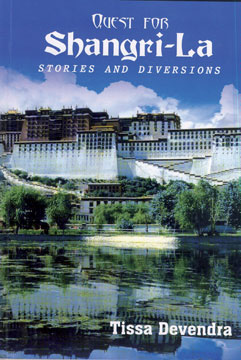|

Random stories and diversions
Reviewed by Carl Muller
There is something immeasurably attractive about the way Tissa
Devendra puts down his thoughts, moving into the days of his childhood
and youth, memories like those windows of his long-gone world -
snapshots, as he says, in soft focus of the times and the way of life
that palpitates no longer around us.
|

The quest for Shangri-La
Author: Tissa Devendra |
Calling this excellent book his Stories and Diversions, he dedicates
it all to his first-born grandson, Sankya, and his granddaughters
Sahitra and Swyrie, and is wont to say how these memories linger, oddly
enough, long after places have gone,
'Many of my Diversions are random, often irreverent thoughts on the
history and manners of our beloved Sri Lanka' he says, and the artistry
brings back the old to wag fingers at the new.
While he has kept the quest for Shrangri-La for the last of his
Writers, I found so much more in his second story, Dreaming of Tibet,
and of which he has carried a gorgeous cover picture of an ancient Lhasa
Temple clinging to its mountain precipice.
He tells us first of 1920 Colonial Ceylon when Ananda College, headed
by Kularatne, bubbled with patriotic fervour. It was the time when the
college students discarded the colonial symbol of coat and tie to adopt
the Ariya Sinhala dress.
The college was soon a magnet for the icons of Indian nationalism and
students listened enthraled to the Mahatma, to Kamaladevi
Chattopadhayaya, to the Indian poet Sarojini Naidu (who was once known
to have a Sinhalese lover) ... It was also the time when theosophists
Madame Blavatsky and Colonel Olcott were as the guiding lights of
Buddhist education, and there flowed in other Britishers and Americans
who interacted with the revival of Buddhism.
It was the American scholar of Tibet's Tantrayana Buddhism who was
most interesting. He was W.Y. Evans-Wents. Tissa gives us a title print
of a book - Tibet's Great Yogi Milarepa: A biography from the Tibetan
being the Jetsun-Khabum - Biological history of Jetsun Milarepa
according to the late Lama Kazi Dawa-Samdep's English rendering. This
book was edited with introduction and annotations by Evans-Wentz.
Fascinated
Tissa's father, the famous D.T. also read every book on Tibet he
could find, and Tissa was free, even as a schoolboy, to read all the
books in the home.
He was soon fascinated by the intricately-carved temples, whirling
dragon-dancing monks, yak caravans and the beautiful forbidding
mountains, He leant of yak shepherds, serene monks in strange headgear
or in fearsome masks, the paintings of spirits in conjugal embrace - a
spiritual ecstasy - and the sky burials, where the dead were cut up and
left as food for the mountain eagles.
Tibetan Buddhism held young Tissa enthraled - Lamas in the snow,
meditating in a trance ... others in their small kutis, meditating for
years within walls --- the transference of the spirit of high Lamas to
infant boys. that was the tradition that gave a unbroken of thirteen
earlier Dalai Lamas.
It was another book, Seven Years in Tibet, by Heinrich Harrer that
told Tissa of the present Dalai Lama's flight from Lhasa's Forbidden
Kingdom to Indian where he fashioned a Little Tibet at Dharamsala in the
foothills of the Himalayas.
Tissa has held scant toleration for the Communist China of Chairman
Mao that brutally invaded Tibet. Books gave the western stories of
ill-armed Tibetan guerrillas and stave-wielding Lamas who resisted the
Chinese Peoples Army and the Red Guards.
Many Tibetans perished, many fled to Indian and China established
administrative control, abolished the clerical regime and dragged
medieval and monastic Tibet, kicking and screaming, into the 20th
century.
Pop icon
Tissa has little love for the Dalai Lama too, who had learned to love
his multi-cultural freedom in Dharamsala, attracted journalists,
politicians, and film stars, and travelled the western world,
establishing Tibetan monasteries in America and Britain. Tissa was
saddened by the way the Dalai Lama became a sort of pop icon,
compromising his moral stature to hobnob with Presidents, Prime
Ministers and Hollywood stars, even blessing the US President for the
thousands of deaths in Iraq and Afghanistan.
Today there is a high-speed railway linking Lhasa to Beijing and
Tissa's Tibet of his dreams lies buried in the permafrost of history.
But he does not forget Evans-Wentz who left behind The Tibetan Book of
the Dead. Decades later, this became a 'sacred text' of the Hippie -
Beat LSD movement.
I would like to drop down to Tissa's 14th story: Malalasekera's
Dream. It is not that I wish to confuse readers but I feel that this
story carries much that deserves to be told of. Mind you, should this
article be too long for my editors, I have already patterned a Part 2,
maybe Part 3 as well.
Will my editor mind? I think not on page 79 we have Malalasekera's
Dream: The World Fellowship of Buddhists, and Tissa's memory takes him
back to that very first 1950 gathering in Ceylon - a gathering that
gazve impetus and inspiration for the 1956 Buddha Jayanthi celebrations.
This Vesak, we celebrate the 2,600th Golden Jubliee of the Buddha
Jayanthi. the first 1950 gathering was the need, the dream, to knit
together the many Buddhist organizations and scholars the world over,
especially those of Buddhist culture and traditions.
As Tissa says, Asia was then emerging from the dark clouds of
Colonialism. This gathering would not allow the rising flood of western
materialism to submerge the old ways.
Malalasekera was a leading member of the Young Men's Buddhist
Association (YMBA), and President of the All Ceylon Buddhist Congress
(ACBC). He was also dean of the University Faculty of Oriental Studies,
and in setting up his core group, made his dear friend D.T. Devendra,
his key player.
Such a gathering it was ... King Sisavong vong of Laos; Rani Dorji of
Bhutan; Princess Poon Diskul of Tahiland. There was also Ambedkar and
Zen Scholar Dr. D.T. Suzuki; Major-General Tunttla Aung of Burma. ...
Bhikkhu Sujivo of Thailand told of why Thai Bhikkhus wore shorter robes
to avoid mud when walking through fields, and he also introduced the
saffron sling-bags that had never been seen or used before in Ceylon.
There were elegant Japanese Buddhist women from Hawaii, and the
Chinese twins, both with wispy beards, from Hong Kong. The Catholic MTF.
Minister of Religious Affairs represented Emperor Bao Dei of Vietnam,
and England was represented by Miss E. B. Homer, a Pali scholar, and
Cyril Moore.
Tissa, who was a bit-player at the gathering, also met Mademoiselle
Suzanmne Karpeles who came from France's Les Amis du Budhisme. (Is that
The Friends of Buddhism?).
It was soon noted that our Bauddha Kodiya - so popular here, was not
known abroad. Malalasekera then made of it the universal symbol of
Buddhist unity. He placed hundreds of the little silk flags on the
delegates desks and these were eagerly taken back to the delegates home
countries.
This story takes me back to 1956 when I sailed on Her Majesty's Ship,
Vijaya, to Burma, carrying a statue of the Buddha as a gift to the
Schwedagon monastery and pagoda. Our Chief Signals Officer hoisted the
Buddhist Flag on the main mast while we were alongside Queen Elizabeth
pier, and this brought signals from many ships in harbour.
A Canadian destroyer actually slipped moorings to come alongside,
asking if we were in trouble. "What is that strange flag?' we were
asked. It took time to explain, for any flag not known of in the Book of
International Signals only meant that the ship was in serious trouble.
There have been instances of a ship in "labour" even hoisting a broom
and a bucket!
Glory
It is now time to take on the first Diversion on page 120, titled The
First and Last Tissa. As Tissa says: "Having been named Tissa by my
parents, I was, as a schoolboy in the 1940s, basking in reflected glory
whenever a King Tissa appeared in our history books".
Again, the wandering mind - The Arahat Mahinda called to our hunter
king, Tissa! Tissa! Reading the 'Rajavaliya', Tissa discovered that
Devanampiya Tissa was not the first Tissa who answered Mahinda's
summons. His father was Mota Tissa, and Mota's father, who was the son
of Pandukabhaya, was Gana Tissa. So there was a pre-Buddhist usage of
the name.
There was also some of the early Buddhist disciples: Mogaliputta
Tissa, and the name was also adopted by twenty kings - Suiddha Tissa,
the pious; Sura Tissa, the fierce; Deta/Jetta Tissa, senior, and Upa
Tissa, junior; Kuda Tissa, the little; Kelani Tissa; Yatala Tissa; Kavan
Tissa, the crow-black; Mahadalioya Tissa of the big beard; Vankanasika
Tissa, the crooked-nosed; and Voharaka Tissa, the loud mouthed; Dalpa
Tissa, a rather obscure ruler who reigned for nine years.
Buddhist monks will occasionally use the name Tissa to this day, but
the name seems to have gone into hibernation for nearly 1,000 years.
Anyway, our Tissa found his first post-Mahavamsa friend: Tissa
Amerasekara, and a most wonderful man at that. As he says, 'His
achievements in Literature and in film, his brilliance in Sinhala and
English, left an indelible imprint to be long remembered and studied.
It is our tragedy that he left us at the height of his creative power
and I dedicate this in memory of the greatest Tissa of our age'.
Well - I have still so much to tell of. So many Stories, Diversions
and Writers. Let's go on to part 2. How about Karapothas, Kan-Kun, Kokis
and the Kakkussiya?
|

